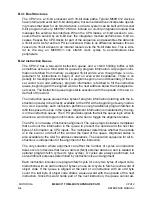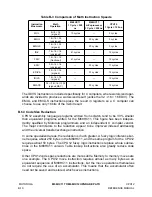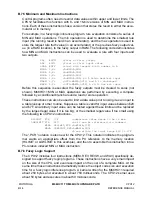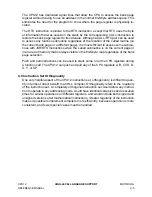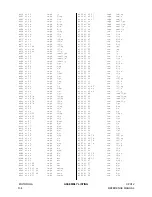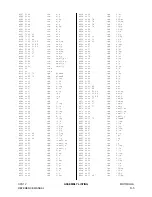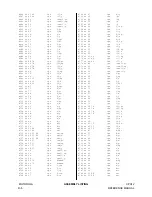
CPU12
M68HC11 TO M68HC12 UPGRADE PATH
MOTOROLA
REFERENCE MANUAL
B-13
B.7.1 Memory-to-Memory Moves
The CPU12 has both 8- and 16-bit variations of memory-to-memory move instruc-
tions. The source address can be specified with immediate, extended, or indexed ad-
dressing modes. The destination address can be specified by extended or indexed
addressing mode. The indexed addressing mode for move instructions is limited to
modes that require no extension bytes (9- and 16-bit constant offsets are not al-
lowed), and indirect indexing is not allowed for moves. This leaves a 5-bit signed con-
stant offset, accumulator offsets, and the automatic increment/decrement modes.
The following simple loop is a block move routine capable of moving up to 256 words
of information from one memory area to another.
LOOP
MOVW
2,X+ , 2,Y+ ;move a word and update pointers
DBNE
B,LOOP
;repeat B times
The move immediate to extended is a convenient way to initialize a register without
using an accumulator or affecting condition codes.
B.7.2 Universal Transfer and Exchange
The M68HC11 has only eight transfer instructions and two exchange instructions.
The CPU12 has a universal transfer/exchange instruction that can be used to transfer
or exchange data between any two CPU registers. The operation is obvious when the
two registers are the same size, but some of the other combinations provide very
useful results. For example when an 8-bit register is transferred to a 16-bit register, a
sign-extend operation is performed. Other combinations can be used to perform a
zero-extend operation.
These instructions are used often in CPU12 assembly language programs. Transfers
can be used to make extra copies of data in another register, and exchanges can be
used to temporarily save data during a call to a routine that expects data in a specific
register. This is sometimes faster and produces more compact object code than sav-
ing data to memory with pushes or stores.
B.7.3 Loop Construct
The CPU12 instruction set includes a new family of six loop primitive instructions.
These instructions decrement, increment, or test a loop count in a CPU register and
then branch based on a zero or non-zero test result. The CPU registers that can be
used for the loop count are A, B, D, X, Y, or SP. The branch range is a 9-bit signed val-
ue (–512 to +511) which gives these instructions twice the range of a short branch in-
struction.
B.7.4 Long Branches
All of the branch instructions from the M68HC11 are also available with 16-bit offsets
which allows them to reach any location in the 64-Kbyte address space.
Summary of Contents for CPU12
Page 8: ...MOTOROLA CPU12 viii REFERENCE MANUAL ...
Page 14: ...MOTOROLA INTRODUCTION CPU12 1 4 REFERENCE MANUAL ...
Page 20: ...MOTOROLA OVERVIEW CPU12 2 6 REFERENCE MANUAL ...
Page 38: ...MOTOROLA INSTRUCTION QUEUE CPU12 4 6 REFERENCE MANUAL ...
Page 300: ...MOTOROLA DEVELOPMENT AND DEBUG SUPPORT CPU12 8 16 REFERENCE MANUAL ...
Page 338: ...MOTOROLA MEMORY EXPANSION CPU12 10 8 REFERENCE MANUAL ...
Page 364: ...MOTOROLA INSTRUCTION REFERENCE CPU12 A 26 REFERENCE MANUAL ...
Page 386: ...MOTOROLA HIGH LEVEL LANGUAGE SUPPORT CPU12 C 6 REFERENCE MANUAL ...
Page 438: ...MOTOROLA SUMMARY OF CHANGES CPU12 S 2 REFERENCE MANUAL ...
Page 439: ......






